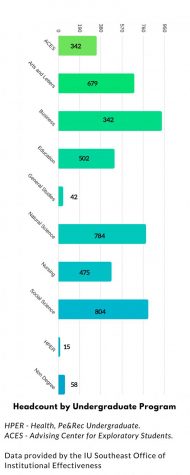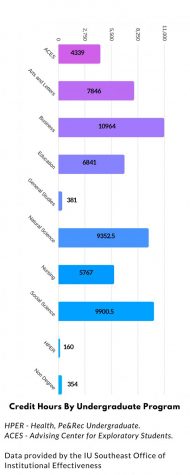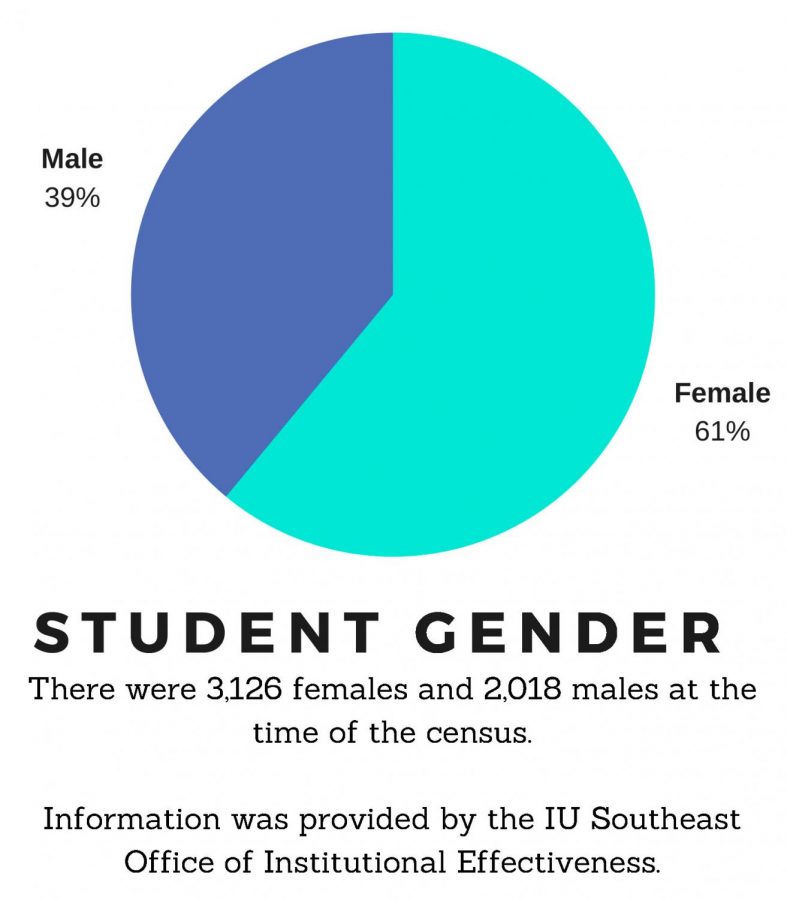Fall 2018 Census Overview
Census data paints a picture of the campus with demographic and enrollment information
October 17, 2018
Every fall, a census is taken by the Office of Institutional Effectiveness at IU Southeast to collect student headcount, credit hours and demographic numbers. The data is used to provide information about student satisfaction, student experience and engagement and is factored into the campus budgeting.
The information shows where improvements are being made and what areas still need work.
Demographics
According to the IU Southeast Office of Institutional Effectiveness, this fall, 82 percent of students attending IU Southeast were Caucasian.
Other ethnicities in the student headcount include six percent African American, five percent Hispanic, four percent Mixed Race, two percent Asian, one percent NR-Alien and one percent Race/Ethnicity Unknown.
“Our number of minority students is increasing each year,” Amanda Stonecipher, vice chancellor of enrollment management and student affairs at IU Southeast, said.
According to the Fall 2017 Quick Facts, 15.8 percent of the undergraduate student population were minorities. This fall, the number has slightly increased.
“Our minority enrollment goal is to mirror its service region minority population of citizens 18 to 24 years of age,” Stonecipher said.
According to the Indiana University Annual Report for 2017 – 2018, the service region minority population is at 13.2 percent. IU Southeast has continued to reach the goal for minority population by having a 16 percent domestic minority headcount.

Of the students attending this fall at the time of the census, 61 percent were female while 39 percent were male.
“Our campus trends reflect the national trends,” Stonecipher said.
Most students attending campus were traditional, or younger than the age of 25. 30 percent of students were non-traditional, or over the age of 25.
“There are a lot of reasons why we have non-traditional students,” Kimberly Pelle, coordinator of non-traditional student programs, said. “Some of these students are lifelong learners that are continuing education, displaced workers, students changing careers or looking for better careers, or students who didn’t come to college right out of high school.”
Most students were in the state of Indiana or from the region, with 68 percent being Indiana residents and 30 percent under reciprocity agreements where students from out-of-state can enroll for a reduced tuition charge.
Overall, 32 percent of students were first-generation college students this semester.
Headcount and Credit Hours
According to the IU Southeast Office of Institutional Effectiveness, the student headcount was 5,144 students on campus at the time of the census. Of those students, 4,659 students were undergraduates and 485 were graduates.
The school with the most enrolled undergraduate students was the School of Business, with a headcount of 926 students.
The top five academic units by undergraduate headcount at the time of the census after the School of Business was the School of Social Sciences – 804, Natural Sciences – 784, Arts and Letters – 679, Education – 502 and Nursing – 475.
At the time of the census, the general studies program had begun the process of migrating to fall under the School of Arts and Letters.
The school with the most enrolled graduate students was also business, with a headcount of 185 students.
Other graduate headcounts included education – 141, interdisciplinary studies – 29, nursing – 16 and social sciences – 15.
There was a 17 percent increase in graduate headcount compared to the previous fall census for all students, while there was a decrease in undergraduate headcount of 3 percent for all students.
For the degree-seeking headcount, there was a decrease of four percent in the undergraduate headcount and an increase of 11 percent in the graduate headcount.

Some programs had increases in headcount, while others saw slight decreases. This semester, the headcount for the Advising Center for Exploratory Students (ACES) academic unit was 342 at the time of the census, a 5.9 percent increase over the 323 students that were under the program last fall.
The School of Business saw a decrease of 83 students over last fall, although their graduate programs saw an increase of 32 students.
The degree with the highest headcount this fall was the bachelor of science in business, with 457 students in pre-business and 425 in the bachelor of science.
Following business in headcount was the elementary education program.
There were 149 students in the pre-elementary education program and 96 in the elementary education program.
There were 328 undecided baccalaureate students at the time of the census.
In total, students were taking 58,715 credit hours at the time of the census. Females were taking 36,084 credit hours and males were taking 22,631.
Since fall of 2017, there was a one percent increase in credit hours for female students. For male students, there was a decrease in four percent.
In addition to degrees, students were also pursuing certificates, post-baccalaureate programs, additional licensing and other credentials.
“Campus-wide enrollment data can be found in the Fall 2018 Census Quick Facts, which compares enrollment from last fall to this fall,” Ronald Severtis, Jr., director of the office of institutional effectiveness, said. “In sum, the headcount change was a decrease of 1.8 percent and the credit hour change was a decrease of 1.1 percent.”
Although there were minor decreases in headcount and credit hours, the decreases were much smaller than the 2017 numbers.
The undergraduate headcount in fall of 2017 had decreased 8.5 percent from the previous fall and the credit hours had decreased 4.7 percent from the previous fall.
The census Quick Facts can be found on the Office of Institutional Effectiveness website.
Information on head counts and credit counts can be found on the Indiana University Research and Reporting website.


